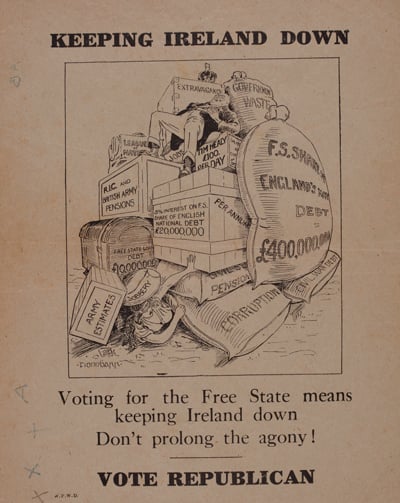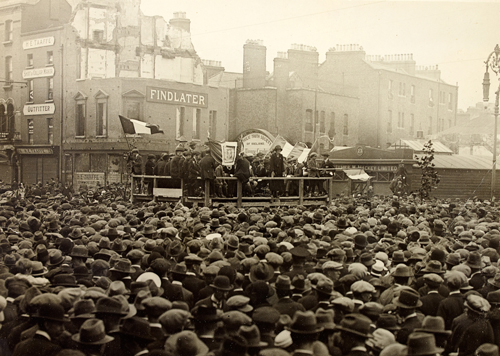Election countdown - candidates set out positions ahead of August 27th polling day
Dublin, 22 August 1923 - With nominations now closed for the forthcoming general election, over 370 candidates will run for 153 seats across 29 constituencies in the next Dáil.
Polling day is set for August 27th, but three seats have already been filled in the fourth Dáil owing to the absence of any competition for the three seats allocated to the Trinity College, Dublin (TCD) constituency. The three candidates who stood unopposed for the Trinity seats - Prof. E. H. Alton, Sir James Craignand , Prof. W. E. Thrift - were all members of the outgoing Dáil.
Given the backdrop of recent civil war, the intensity with which the campaign has been fought throughout the 26 counties was to be expected. And while there have been no major disturbances thus far, tensions between different political factions have occasionally spilled over.

1923 general election handbill Sinn Féin (Image: National Library of Ireland)
The circumstances around the arrest in Ennis, Co. Clare, of Eamon de Valera, is reported elsewhere in this edition of Century Ireland, but some unsavory incidents have also been reported from other constituencies. In Co. Mayo, the tyres of a motor car used for campaigning purposes by Cumann na nGaedhael were slashed at Aughagower in the south of the county, while in the town of Westport a number of flag-bearing Republican women were set upon by other women when they arrived at the scene of a rally at which local Cumann na nGaedhael candidates were speaking. It took an intervention by the Civic Guards to ensure the safety of the attacked women.
In Co. Louth, meanwhile, hecklers turned up to disrupt a republican election gathering on the Cooley Peninsula.
However, this election is not simply a contest between the pro and anti-Treaty parties. Labour is also contesting and campaigning vigorously, as is the Farmers’ Party amongst others . Addressing a gathering in Dun Laoghaire Town Hall, Farmers’ Party candidate, Dr. John Fitzsimons said that the country just wanted to get back to peace and was sick and tired of the politics of the last six or seven years.
Yet it is the very issues that were to the fore during these
recent years and the legacy of the constitutional arrangements
that were reached that are everywhere during this campaign.
When President Cosgrave toured his Kilkenny constituency -
on a single night he travelled 60 miles and addressed five
gatherings, the last concluding just before mid-night - he was met
by opposition supporters with cries of ‘Up de Valera’
and ‘Who attacked the Four Courts.’
Challenged in Freshford on the issue of partition, Mr. Cosgrave said Mr. de Valera had been the first to agree to the particular clause in the Treaty and had included the same clause in Document No. 2. However, while Mr. Cosgrave attacked the record of Mr. de Valera, elsewhere in the county a Kilkenny republican demonstration was held to protest against Mr. de Valera’s arrest. Here, the attendance was told that the most emphatic protest the people of Kilkenny could make was to hurl Mr. Cosgrave out of public life.
[Editor's note: This is an article from Century Ireland, a fortnightly online newspaper, written from the perspective of a journalist 100 years ago, based on news reports of the time.]





















